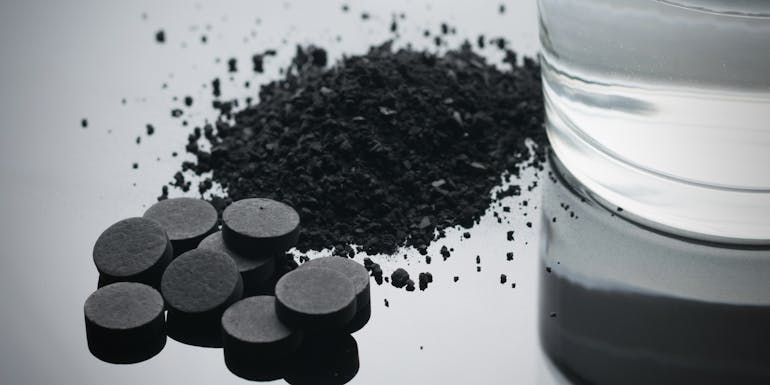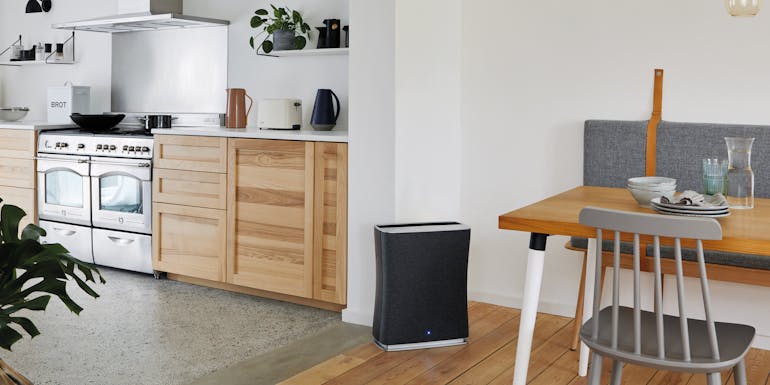
Nadine Walder , 11 November 2024
Neutralise odours
Combat odours with an activated carbon filter
Have you ever come home to an unpleasant odour? Bad odours in your flat, house or other premises can quickly become a nuisance and you want to get rid of them as quickly as possible. Whether it's food odours, pet odours or the smell of smoke – nobody wants their home to smell unpleasant. But sometimes these unpleasant odours can become stubbornly entrenched. Before you despair, read this article. We'll show you a practical and effective solution for eliminating odours, even stubborn ones.
Read on to find out:
- What is activated carbon and where is it used?
- Why are activated carbon filters effective against odours?
- How air purifiers with activated carbon filters work
- Practical tips for air purifiers with activated carbon filters
What is activated carbon and where is it used?
Activated carbon, also known as medical carbon, is a fine-grained, highly porous material that usually consists of more than 90 % carbon. The tiny pores are interconnected, similar to a sponge. This property gives activated carbon an immense internal surface area, namely between 300 and 2’000 square meters per gram. To illustrate: the internal surface area of 2 grams of activated carbon is roughly equivalent to the surface area of a football pitch. The highly porous structure enables activated carbon to effectively adsorb pollutants, chemical compounds and odour molecules, i.e. to bind them to the surface. The pore sizes of the activated carbon, which are divided into micropores (less than 1 nm), mesopores (1-25 nm) and macropores (over 25 nm), determine which substances can be adsorbed particularly well. For comparison: a human hair has a diameter of approx. 50,000 nm.
Activated carbon is obtained from various source materials such as wood, peat, nutshells, brown or hard coal, animal blood (blood carbon) or bone (bone carbon). Depending on its origin, activated carbon is referred to as vegetable carbon or, in the case of animal source materials, as animal carbon.
Activated carbon is used in many different areas due to its excellent ability to bind unwanted substances. It is typically used in the form of granules, powders or pellets. Possible applications include:
- Industrial applications: Activated carbon is used in the chemical and food industries to remove colouring or interfering substances from liquids.
- Food industry: Activated carbon is approved as a colouring agent E 153 and is found in products such as jam, confectionery or as a black wax coating on cheese.
- Water treatment: Activated carbon is used to remove chlorine, ozone and other unpleasant odours and flavours from water. It is also used in wastewater treatment to remove dissolved pollutants.
- Medicine: Activated carbon is used to treat poisoning as it can bind toxins swallowed orally in the digestive tract. It is also used in the form of carbon tablets for gastrointestinal complaints.
- Cosmetics: In cosmetics, powdered activated carbon is used in shower gels, face masks, peelings and toothpaste to adsorb harmful substances.
- Car: Activated carbon filters are used in cars to adsorb toxic gases and unpleasant odours.
In addition to these areas of application, activated carbon is also widely used in air purification and odour neutralisation. The following section explains how this works.
Why are activated carbon filters effective against odours?
Activated carbon is particularly effective in combating odours because it traps the molecular compounds responsible for the bad smell in its pores. Activated carbon bags, for example, are suitable for smaller applications. These are used in the following places, among others:
- In the fridge: Activated carbon bags or pads in the fridge help to neutralise odours from foods such as cheese and fish. This keeps the air in the fridge odour-free and fresh.
- In shoes: Bad-smelling shoes are a problem that many people are familiar with. There are special activated carbon soles, or you can simply place an activated carbon bag in the shoe overnight and it will smell nice again.
- In drawers and cupboards: Bags or small filters made of activated carbon are also suitable for adsorbing bad odours in cupboards or drawers.
- Waste bin: A small activated carbon bag in or next to the waste bin helps to prevent unpleasant waste odours.
In addition to these localised applications, larger activated carbon filters are suitable for large-scale and effective odour removal. As already mentioned, activated carbon filters work according to the principle of adsorption. In contrast to absorption, where a liquid is absorbed into a solid, in adsorption the molecules adhere to the surface of the activated carbon. Due to its large inner surface area, activated carbon can capture a large number of molecules, making it ideal for odour removal.
In addition, activated carbon filters not only bind odour molecules, but also volatile organic compounds (VOCs) that can be released by products such as paints, cleaning agents or furniture. This improves the odour and the overall air quality. Activated carbon filters are particularly effective when used in conjunction with an air purifier.
How air purifiers with activated carbon filters work
Air purifiers with activated carbon filters draw in the room air and pass it through the filter, which is coated with activated carbon. The highly porous structure of the activated carbon binds the odour molecules and pollutants. This purifies the air and removes unpleasant odours. These devices are often combined with a HEPA filter, which can also remove dust, pollen and other particles from the air.
An activated carbon filter is particularly suitable for neutralising gaseous pollutants and unpleasant odours, for example:
- Cooking and food odours: The air purifier removes food odours from the air and ensures that the home does not smell of the last meal.
- Pet odours: Pet owners know the problem: despite regular cleaning, it can sometimes smell of dog, cat or other pets. An air purifier with an activated carbon filter can reduce these odours.
- Chemical odours: Cleaning agents, paints or solvents can smell unpleasant. Activated carbon filters can help to remove such odours from the air.
- Smoke odours: Whether smoke from the fireplace or cigarette smoke, air purifiers with activated carbon filters can neutralise these unpleasant odours.
Practical tips for air purifiers with activated carbon filters
When buying and using an air purifier with an activated carbon filter to eliminate odours, there are a few things you should consider. Here are some tips to ensure that the air purifier works optimally:
- Filter size and thickness: There is a simple rule – the more activated carbon in the filter, the more odour molecules it can adsorb. Make sure you have a filter with enough activated carbon so that it can work effectively in your home.
- Combination with HEPA filter: For comprehensive air purification, it makes sense to choose an air purifier that has both an activated carbon and a HEPA filter. In addition to odours, particles such as dust and pollen are also filtered out of the air. Please note: a HEPA filter alone cannot filter odours.
- Placement: It is advisable to place the air purifier near the source of the odour, for example in the kitchen or living room. Make sure that there is enough space around the appliance so that the air can circulate sufficiently.
- Regular filter replacement: Activated carbon filters must be replaced regularly. The replacement interval is usually specified by the manufacturer and is generally between 3 and 6 months. This depends on how the filter is stored and whether the air purifier is in continuous operation. As soon as activated carbon comes into contact with the air, it is consumed. If you buy an activated carbon filter and do not need it immediately, be sure to leave it sealed in the packaging. If you do not need the air purifier for a longer period of time, we recommend that you remove the activated carbon filter and pack it in an airtight bag. How quickly the filter wears out also depends on the amount of odour molecules it has to adsorb. The more odour molecules, the faster the activated carbon is used up.
Activated carbon is a simple, natural and versatile solution for getting rid of unpleasant odours. Air purifiers with activated carbon filters offer an effective way to improve the air quality at home and ensure fresh, pleasant air. Try it out for yourself and declare war on unpleasant odours.
Would you like to find out more about air purification? On our information page you will find useful tips and tricks as well as everything you need to know about indoor air purification.
If you have questions related to indoor room climate, please get in touch with us. Or subscribe to our newsletter to regularly get informed about current topics regarding indoor climate, experience reports or Stadler Form insights.



















